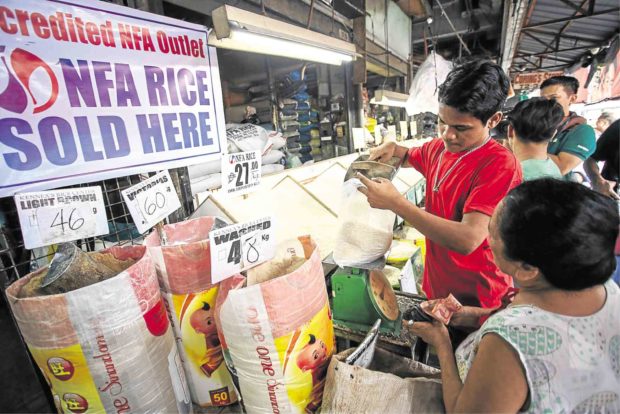Solving the crippling rice crisis

Images of the poor forming long lines to buy rice. Grain stocks infested with weevils. The cost of the most basic food hitting the consumer hard.
A rice price crisis is indeed gripping the Philippines again.
In an extreme case, the price of rice shot up from P30 to P80 per kilogram in Basilan, now put under a state of calamity due to the shortage.
People there are resorting to eating cassava, or “kamoteng kahoy,” which the poor can afford.
In contrast, rice imported from Vietnam and Thailand is only around half the price in the Philippines.
According to the World Bank database, the high grade “5 percent broken” rice from Vietnam is at $419 per metric ton. One can assume an exchange rate of P53.5 per US dollar, and include a 20 percent markup for transportation and profit. That translates to just P26.90 a kilo.
Even raising the markup to 30 percent results in a price of just P29.14 per kilo.
That is why the National Food Authority (NFA) buys rice from these countries.
Vietnam and Thailand produce rice cheaply because of their large river systems, the Mekong and Chao Phraya, respectively.
Nature has not blessed the Philippines with rivers like these.
But the NFA has long held a monopoly on rice imports.
Allowing the private sector to import massively will totally change the game.
A study in 2015 by Roehlano Briones and Lovely Ann Tolin of the Philippine Institute for Development Studies looked at how prices would change if rice imports were liberalized.
At that time, rice was sold on retail at an average of P32 per kilo.
The research found that liberalized imports would slash rice prices by as much as P6.97 per kilo. That discount should be greater now in 2018.
It would be antipoor to continue with rules that keep rice prices high.
Key to cleaning up the mess is to overhaul the NFA or replace it with a new agency altogether.
As it is, the NFA follows three mandates, and the first two contradict each other. These are: 1) to keep rice prices moderate for the sake of consumers, 2) to protect the income of the rice farmers, and 3) to maintain strategic rice reserves.
Hence the NFA keeps losing money by buying high from the farmers and selling low to the consumers.
That’s why it has accumulated more than P170 billion in debt.
How then should the rice regime be changed?
Dr. Emil Javier is the Chair of the Coalition for Agriculture Modernization in the Philippines.
He wrote a think piece titled, “Wanted: A new rice industry road map after lifting of quantitative restrictions.”
He says that with liberalizing rice imports, the objective must shift from rice self-sufficiency to boosting the income of the farmers.
“Better that we divert the not so productive rice areas into other higher value crops (crop diversification and multiple cropping),” he says. “We will produce less rice but the additional gross value added from these other crops will more than make up for the rice shortfall.”
Rice demands much water for cultivation, so irrigation is a key issue.
Javier says it is best to put more irrigation into the more productive irrigated areas, and use the non-irrigated land for other high value crops.
The goal is to raise rice cropping intensity to 2.0, or yielding two crops per year on the same field. As it is, cropping intensity is just 1.57, so this needs investing in more shallow tube wells, water pumps and small reservoirs.
At the same time, convince farmers with non-irrigated land to earn more by planting cacao, coffee, legumes, vegetables and ornamentals.
Javier calls for limiting NFA’s mandate to just “maintaining our strategic grain reserves, and to rice distribution during emergencies.”
That’s the way to go: cut rice prices sharply via imports, boost farmer incomes via diversification and use NFA just for emergencies.
